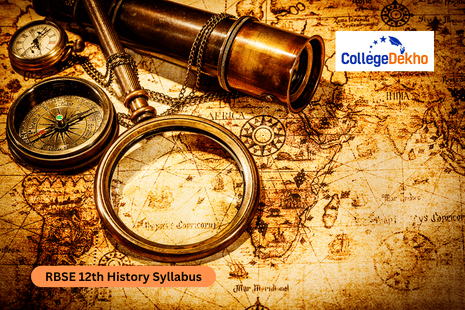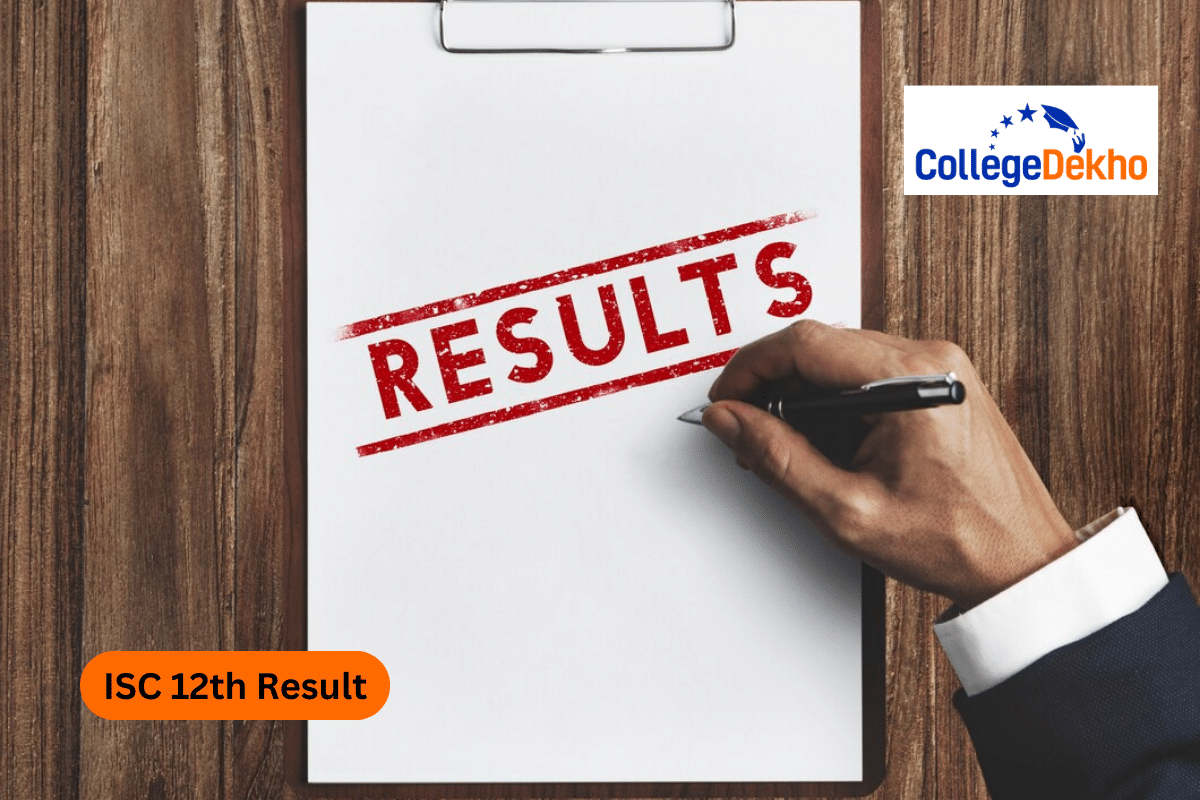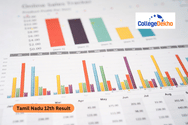

Never Miss an Exam Update
RBSE 12th History Syllabus 2025-26 is available on the official website at rajeduboard.rajasthan.gov.in. The syllabus is divided into 3 parts (Themes in Indian History Part-I, Themes in Indian History Part-II, and Themes in Indian History Part-III) and 12 themes where each part has 4 themes.
The weightage of part 1 is 22 marks, part 2 is of 25 marks and part 3 is of 33 marks. The map work will be of 5 marks and the remaining 20 marks will be allocated as per the project work. Important topics to be focused on are Ancient civilizations (Harappan, Mauryan, Gupta), Social and cultural developments (Bhakti-Sufi, Vijayanagara), and Colonial and modern history (Revolt of 1857, Gandhi, Constitution).
Also Check
RBSE 12th Exam Pattern 2025-26
The maximum marks allotted for the RBSE 12th History exam are 100, where 80 marks are for the theory paper and 20 marks for the practical/ project work. The total exam duration is 3 hours and 15 minutes. After preparing well for the RBSE Class 12 History examinations, you must solve the
RBSE Class 12 Sample Papers
to assess your preparation and accordingly work on your weaker sections. The board will conduct the RBSE 12th exam 2025 in March/ April 2025, in pen and paper mode. Students can go through the article below to check the detailed RBSE Class 12 History Syllabus 2025-26.
RBSE Class 12 History Syllabus 2025-26 PDF
The RBSE 12th 2025-26 syllabus comprises the History Syllabus as well as the marking scheme. The PDF file contains the latest RBSE 12th History syllabus PDF in Hindi and English.| RBSE Class 12 History Syllabus 2025-26 Download PDF |
|---|
RBSE Class 12 History Syllabus 2025-26
History is largely a theory-based subject, but students shouldn’t take it lightly. The table below consists of the unit-wise RBSE Class 12 History syllabus 2025-26 along with the marking Scheme.Themes in Indian History Part—I | |||
|---|---|---|---|
Theme No. | Theme Title | Learning outcome with specific competencies | Marks |
1 | Bricks, Beads and Bones The Harappa Civilisation | To investigate, explore and interpret the early urban centres and social institutions. State and deduce the multi- lateral aspects of Harappan civilization to understand the first civilization of the world. Investigate and interpret historical and contemporary sources and viewpoints of ASI and historians on Harappa. | 25 |
2 | Kings, Farmers and Towns Early States and Economies (c.600 BCE600 CE) | To assess and analyze important developments in the subcontinent's political and economic history. Interpret inscriptional data. Examine the ways in which inscriptional evidence has influenced our understanding of political and economic processes. | |
3 | Kingship, Caste and class Early Societies (c. 600 BCE600 CE) | To investigate and evaluate social history's problems. Examine social norms to gain insight into the societal viewpoints presented in the ancient Indian scriptures. Analyze the various facets that historians have investigated to comprehend the Mahabharata's dynamic methodology. | |
4 | Thinkers, Beliefs and Buildings Cultural Developments (c. 600 BCE600 CE) | To deduce and contrast the principal theological advancements in ancient India. Explain the elaborate religious sculpture and deduce the meanings concealed within. | |
Themes in Indian History Part—II | |||
5 | Through the eyes of Travellers Perceptions of Society (c. tenth to seventeenth centuries) | To comprehend key elements of the social histories that the travelers recounted and to put what they had learned into practice. clarifying the reports of foreign travelers in order to comprehend the social, political, and economic landscape during the various medieval rulers' reigns. Examine and contrast Bernier, Ibn Battuta, and Al Biruni's viewpoints on Indian society. | 25 |
6 | Bhakti-Sufi Traditions Changes in Religious Beliefs and Devotional Texts (c. eighth to eighteenth centuries) | Recognize the changes in religion. Compile a summary of the teachings of various Bhakti and Sufi saints in order to comprehend the evolution of religion during the Middle Ages. Understand the religious movement to bring society together, promote harmony, peace, and fraternity. | |
7 | An Imperial Capital – Vijayanagar (c. fourteenth to sixteenth centuries) | Students will be able to categorize the unique architectural contributions made by the Vijayanagar empire in order to appreciate the diversity of the blended cultures found in Deccan India. Examine foreign visitors' reports of Vijayanagar to gain insight into the political, social, and cultural aspects of the city's existence. Evaluate and value the water management system, the city planning, and the rulers' administration. | |
8 | Peasants, zamindars and the States Agrarian Society and the Mughal Empire (c. sixteenth-seventeenth centuries) | Gain an understanding of the aspects of agricultural developments to comprehend the state-agriculture relationship during the Mughal era. Examine and contrast the agricultural transformations that transpired in the sixteenth and seventeenth centuries. Create a table and highlight the variations within the agricultural industry. | |
Themes in Indian History Part—III | |||
9 | Colonialism and The Countryside Exploring Official Archives | Examine the British-instituted revenue schemes to comprehend the economic facets of colonization in India. Examine official colonial records and reports to comprehend the disparate interests of Indians and British. Determine what steps should be taken in this century to protect the artisans and peasants. | 25 |
10 | Rebels and Raj 1857 Revolt and its Representations | To examine the events of 1857. Establish a correlation between the 1857 rebels' planning and coordination to deduce their domains and nature. Analyze the revolt's momentum to comprehend how it spread. Examine how the Indians' vision of unity was sparked by the revolt. Analyze visuals to comprehend the feelings that the British and nationalists are portraying. | |
11 | Mahatma Gandhi and the National Movement Civil Disobedience and Beyond | Recognize the nationalist movement according to its chronology. Establish a connection between the key components of the nationalist movement and the characteristics of the concepts, people, and organizations led by Gandhi. Discuss Gandhi's important contributions to gain an understanding of his widespread appeal for nationalism. Examine the various approaches to interpreting historical sources, including diaries, letters, autobiographies, and biographies. | |
12 | Framing of the Constitution The Beginning of a New Era | Highlight the role of Constituent Assembly to understand functionaries in framing the constitution of India. Analyse how debates and discussions around important issues in the Constituent Assembly shaped our Constitution. | |
-- | Including Map work of the related Themes | -- | 05 |
-- | Theory Total | -- | 80 |
-- | Project Work | -- | 20 |
-- | Total | -- | 100 |
RBSE 12th History Syllabus 2026 Unit-Wise
You can go through the detailed RBSE 12th Class History Syllabus 2025-26 unit-wise from the table below:
Themes in Indian History Part I Part I- Theme 1- 4 |
|---|
|
Prinsep and Piyadassi, The Earliest States –The sixteen mahajanapadas, First amongst the sixteen : Magadha , An Early Empire- Finding out about the mauryas, Administering the empire , Importance of Maurya Empire, New Notions of Kingship- Chiefs and Kings in the south , Divine kings , A Changing Countryside, Popular perceptions of kings , Strategies for increasing production, Differences in rural society, Land grants and new rural elites, Towns and Trade – New cities, Urban populations : Elites and Craftspersons, Trade in the subcontinent and beyond,Coins and kings, Back to basics: inscriptions deciphered, Deciphering Brahmi, Kharosthi Script, Historical evidence from inscriptions, The Limitations of Inscriptional Evidence. |
|
|
Themes in Indian History Part-II Part –II- Theme 5 - 8 |
|
|
|
|
Themes in Indian History Part-III Part –III- Theme 9 - 12 |
|
|
|
|
How to Download RBSE 12th History Syllabus 2025-26 Pdf Download
Students preparing for the RBSE 12th exam 2025 must go through the entire syllabus carefully and schedule their time table accordingly. Moreover, the detailed steps to download the RBSE 12th 2025-26 History syllabus is given below.- Step 1: Visit the official website of the board.
- Step 2: Navigate to the home page and click on the 'अनुदेशिका 2020 एवं पाठयक्रम 2025-26’ in the left-hand panel.
- Step 3: The "RBSE 12th Syllabus 2025-26" link will be displayed on the screen.
- Step 4: Click on the "RBSE 12th History Syllabus 2024" link and the PDF file for all the subjects will be displayed on the screen.
- Step 5: Download the syllabus and start preparing for the board examination.
RBSE Class 12 History Question Paper Design 2025-26
The students can check the sections in the History question paper, number of questions and marks allotted to each of them.
Section | Questions | Total Marks |
|---|---|---|
A | 1 to 3 (sub-parts) | 29 marks |
B | 4 to 16 | 26 marks |
C | 17 to 20 | 12 marks |
D | 21 to 22 | 8 marks |
D | 23 | 5 marks |
Total Marks | 80 | |
For more updates related to the RBSE 12th History syllabus, keep visiting the page.
Are you feeling lost and unsure about what career path to take after completing 12th standard?
Say goodbye to confusion and hello to a bright future!

FAQs
The students should start preparing the RBSE Class 12 History syllabus 2025-26 from the first day. They should not leave the subject to be completed in last couple of months.
The students will find long questions worth 4 and 5 marks in the RBSE Class 12 History exam 2025-26.
Yes, students can complete the RBSE Class 12 History syllabus 2025-26 first and then solve questions to test their knowledge. They can focus on the chapters that require more attention and aim to perform better.
The students should focus on each of the chapters while preparing for the History syllabus. They should also check out the marking scheme for each of the chapters and focus on them accordingly.
The Rajasthan board will conduct the Class 12 History exam for 80 marks. The question paper will include 4 sections.
Was this article helpful?
























